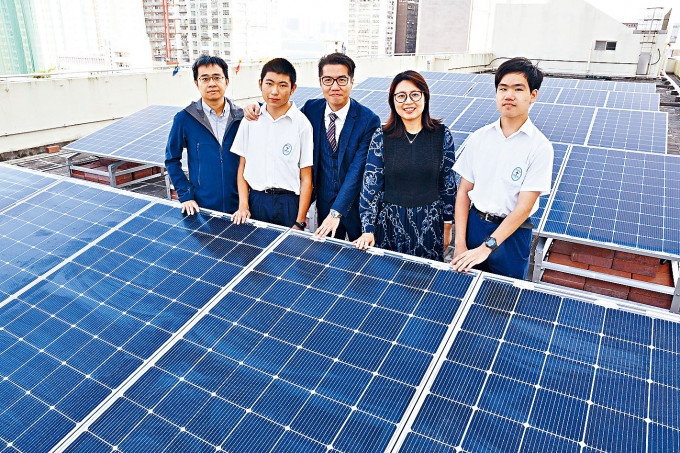- Home
- >
- Latest News
- >
- [Education News] Lau Wing Sang installs solar panels in school to promote environmental protection (Sing Tao Daily)
[Education News] Lau Wing Sang installs solar panels in school to promote environmental protection (Sing Tao Daily)
-

Lau Wing Sang Secondary School installed 35 solar photovoltaic panels through the "Power Sourcing Club" programme, and expects to earn $40,000 a year by joining the "Grid Connection Tariff".
Lau Wing Sang Secondary School is the first secondary school on Hong Kong Island to participate in the "grid-connected electricity tariff" by installing solar photovoltaic panels through the "Power Purchase Club", with a total of 35 solar photovoltaic panels installed on the rooftop of the school, which was formally completed at the end of last year. The teacher in charge of the Environmental and Health Education Section, Mrs Lai Suk-yee, pointed out that based on an average sunshine duration of 3.2 hours, and selling each kilowatt to the Hongkong Electric Company at $5, the school estimated that the actual income from the "grid-connected tariff" would be about $40,000 per annum.
Compared with the school's self-financing installation arrangement, the "Electricity Adoption Society" has to pay all the costs, including the installation of solar panels and application for participation in the "Grid Connection Tariff" and other related expenses. Mrs Lai pointed out that the Electrical and Mechanical Services Department (EMSD), as the contractor, would not only conduct waterproofing tests before and after the installation, but would also be responsible for providing repair and maintenance services during the first year of warranty period. Ten years ago, the school received a grant of $320,000 from the Environment and Conservation Fund (ECF) to build a windmill and 10 solar panels to supply electricity to the school's power grid for its own use, but the efficiency of the project has been greatly reduced so far, and "the current power is only enough to supply one street light". She pointed out that the school had joined the "on-grid tariff" through the programme, so it did not have to worry about power storage problems, and the maintenance cost could also be maintained by the "on-grid tariff" revenue.
Mrs Lai revealed that the installation process faced a lot of difficulties, for example, the optimal tilting angle of the solar panels is 22 degrees facing the south, but it was found that it would cause reflections on the residential area, and she was also worried that the panels would not be able to withstand super typhoons and would be blown away at any time, and she was also worried that if there were leakage in the flooring, it would affect the library downstairs. The Electrical and Mechanical Services Department (EMSD) provided a detailed assessment and gave professional advice on the installation height, angle and waterproofing, including the recommendation to adjust the orientation of the solar panels slightly and the angle to 14 degrees; the use of environmentally friendly bricks pressed against the base to enhance stability; and waterproofing tests before and after the installation to ensure that there would not be any leakage problem on the rooftop before proceeding with the installation.
Speaking of the use of the proceeds from the Feed-in Tariff, Mrs Lai pointed out that it would be used to organise more environmental protection field trips and integrate the concept of "solar energy" into weekday classroom learning activities, including STEM (Science, Technology, Engineering and Mathematics) activities for Secondary One subjects, and the addition of a solar-powered car-making session, so as to enable students to learn knowledge related to energy conversion. At the senior secondary level, Physics will require students to understand the operation of photovoltaic panels. In the "Energy Technology and Environment" module of Liberal Studies, students can also engage in exploratory activities, including the feasibility of implementing solar panels in Hong Kong and how to optimise the use of rooftop space for power generation in order to reduce carbon emissions, which are believed to be of direct benefit to students' learning.
